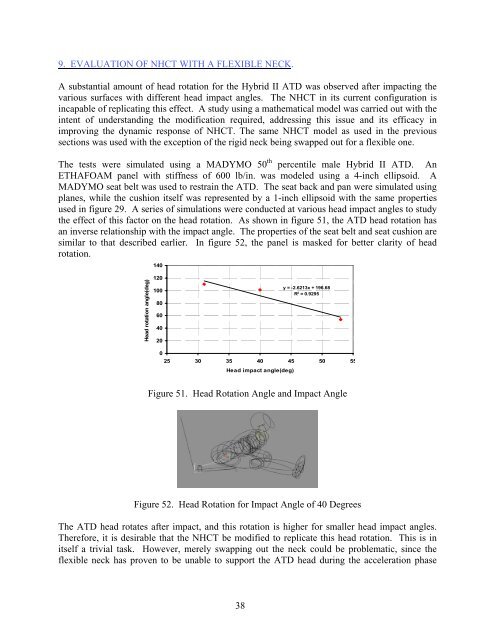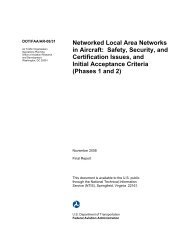Development of a Component Head Injury Criteria (HIC ... - FAA
Development of a Component Head Injury Criteria (HIC ... - FAA
Development of a Component Head Injury Criteria (HIC ... - FAA
You also want an ePaper? Increase the reach of your titles
YUMPU automatically turns print PDFs into web optimized ePapers that Google loves.
9. EVALUATION OF NHCT WITH A FLEXIBLE NECK.<br />
A substantial amount <strong>of</strong> head rotation for the Hybrid II ATD was observed after impacting the<br />
various surfaces with different head impact angles. The NHCT in its current configuration is<br />
incapable <strong>of</strong> replicating this effect. A study using a mathematical model was carried out with the<br />
intent <strong>of</strong> understanding the modification required, addressing this issue and its efficacy in<br />
improving the dynamic response <strong>of</strong> NHCT. The same NHCT model as used in the previous<br />
sections was used with the exception <strong>of</strong> the rigid neck being swapped out for a flexible one.<br />
The tests were simulated using a MADYMO 50 th percentile male Hybrid II ATD. An<br />
ETHAFOAM panel with stiffness <strong>of</strong> 600 lb/in. was modeled using a 4-inch ellipsoid. A<br />
MADYMO seat belt was used to restrain the ATD. The seat back and pan were simulated using<br />
planes, while the cushion itself was represented by a 1-inch ellipsoid with the same properties<br />
used in figure 29. A series <strong>of</strong> simulations were conducted at various head impact angles to study<br />
the effect <strong>of</strong> this factor on the head rotation. As shown in figure 51, the ATD head rotation has<br />
an inverse relationship with the impact angle. The properties <strong>of</strong> the seat belt and seat cushion are<br />
similar to that described earlier. In figure 52, the panel is masked for better clarity <strong>of</strong> head<br />
rotation.<br />
140<br />
<strong>Head</strong> rotation angle(deg)<br />
120<br />
100<br />
80<br />
60<br />
40<br />
20<br />
y = -2.6213x + 196.68<br />
R 2 = 0.9295<br />
0<br />
25 30 35 40 45 50 55<br />
<strong>Head</strong> impact angle(deg)<br />
Figure 51. <strong>Head</strong> Rotation Angle and Impact Angle<br />
Figure 52. <strong>Head</strong> Rotation for Impact Angle <strong>of</strong> 40 Degrees<br />
The ATD head rotates after impact, and this rotation is higher for smaller head impact angles.<br />
Therefore, it is desirable that the NHCT be modified to replicate this head rotation. This is in<br />
itself a trivial task. However, merely swapping out the neck could be problematic, since the<br />
flexible neck has proven to be unable to support the ATD head during the acceleration phase<br />
38

















